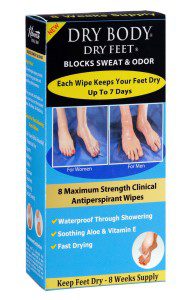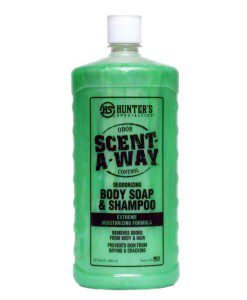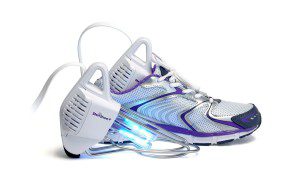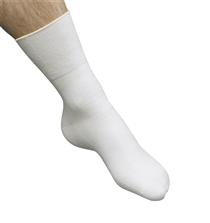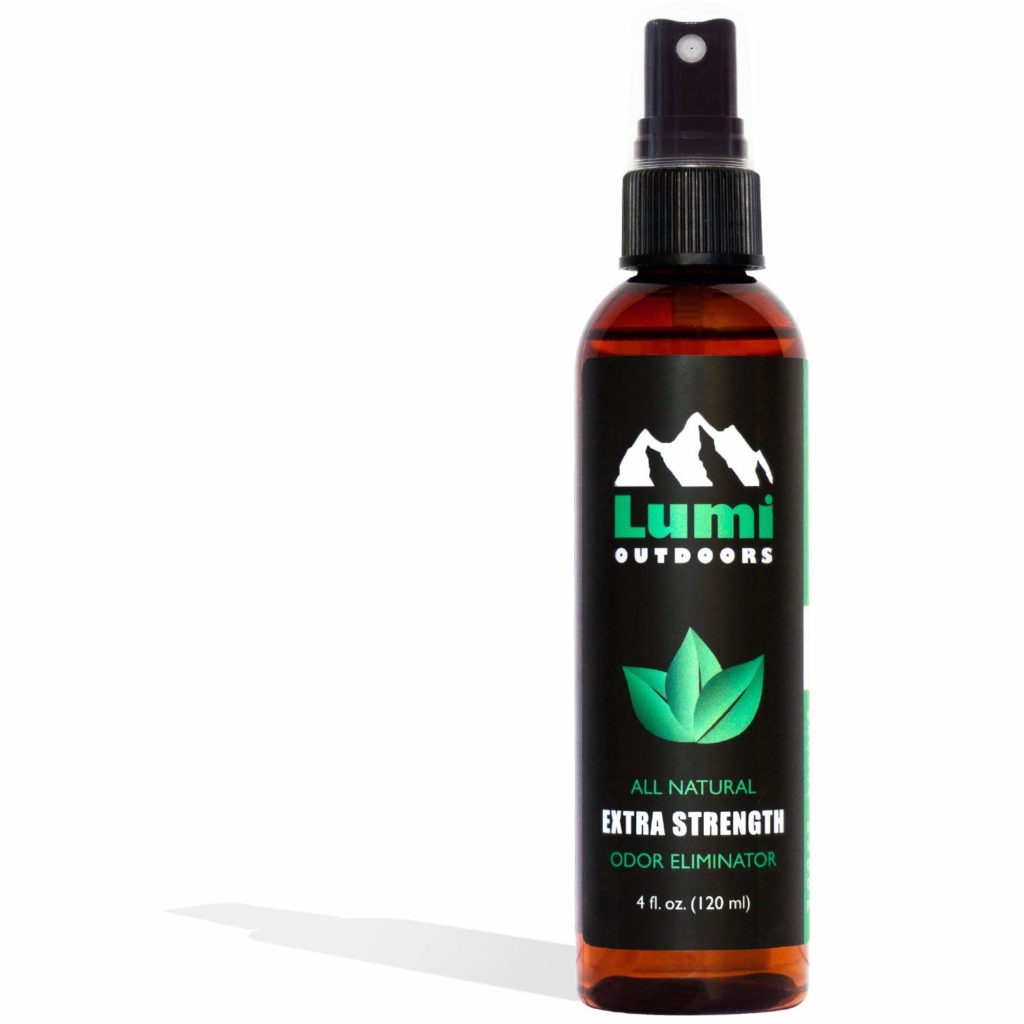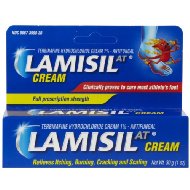Home Treatment and Professional Treatment Options for Sweaty Feet and Foot Odor
Smelly feet (bromhidrosis) and sweaty feet (hyperhidrosis) can be an uncomfortable and embarrassing problem. Fortunately, these problems can usually be treated effectively. On this page we are going to provide some proven self-treatment options. Try them for four weeks. If they don’t work be sure to make an appointment in our Seattle foot clinic or visit your local podiatrist. There are prescription medications and other treatment options that are very effective for those who do not respond to the home remedy below.
The smell associated with sweaty feet is due to the growth of bacteria and fungi that grow rapidly in the moist environment inside a shoe. Our treatment goals are to keep your feet dry and then to combat the growth of the fungi and bacteria. Finally we want to use deodorants to prevent the odor.
Video: Treatment of Sweaty Feet
Treatment of Severe Sweating of the Feet
At the bottom of this page you can find suggestions for home treatment of sweaty feet. These home treatments work well for mild cases, but are usually not effective for moderate and severe hyperhirosis (sweating) of the feet. Patients with more severe sweating should make an appointment to see us in our Seattle clinic to review the treatment options.
Note: The products below are the ones we recommend to our patients and they are also affiliate links so we may receive a small commission at no additional cost to you if your order from the link.
1. OTC Antiperspirants for Feet: Kleinert’s Dry Feet Clinical Antiperspirant is the best OTC antiperspirant we have found for feet. It has 15% Aluminum Choloride which is stronger than that used for underarms. We recomemnd trying this for about three weeks once per day. If you don’t see improvement, then see us or another podiatrist. See more home treatments below.
2. Prescription Strength Antiperspirants: There are several prescription antiperspirants that are much stronger than the OTC antiperspirants. These have over 20% aluminum chloride as the active ingredient. If the Dry Feet Antiperspirant above does not provide relief in three weeks, see us for an evaluation and possibly a prescription. These antiperspirants are especially formulated for the feet. These are often our first line treatment for moderate to severe plantar hyperhidrosis.
3. Iontophoresis for Sweaty Feet: Our second line of treatment for severe sweating of the feet is “tap water iontophoresis”. Treatment of sweaty feet with iontophoresis has been used for over 60 years, is safe and has a high success rate – most studies show over 80%. In this treatment each of your feet is placed into a separate container filled with tap water. These containers are connected to a direct current galvanic unit that sends a current into the water. It is required to do the treatment for 10 – 20 minutes two or three times per week. 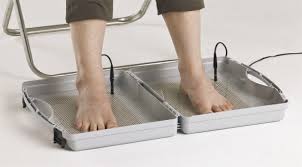
How it works exactly is not completely understood, it is thought that minerals in the water and the electric current itself act to thicken the outer layer of your skin resulting in the sweat being blocked.
If we determine that iontophoresis would be a appropriate treatment for you a prescription is required for you to purchase an iontophoresis galvanic unit, and we will write that for you. Units cost either $675 or $975. The less expensive unit requires you to make some adjustments during the treatment while the more expensive unit requires no adjustments (people using the unit for their hands need the unit with no adjustments because they cannot use their hands to make adjustments. If using only for the feet either unit will work).
The units we recommend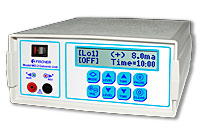 are approved by the FDA for treatment of hyperhidrosis and are occasionally covered by insurance. You will purchase the device directly from the manufacturer and you must bill your insurance yourself. We cannot bill it for you, but we will provide you with the following to help you get coverage:
are approved by the FDA for treatment of hyperhidrosis and are occasionally covered by insurance. You will purchase the device directly from the manufacturer and you must bill your insurance yourself. We cannot bill it for you, but we will provide you with the following to help you get coverage:
- Hyperhidrosis Preauthorization Request Form. We can submit this form for you ahead of purchasing the unit to help you determine ahead of time if it will be covered.
- Letter of Medical Necessity to show that you medically require the iontophoresis unit for treatment of sweaty feet
- Medical Insurance Statement Form for the Purchase of a Home-Use Iontophoresis Device. This is the form that you can submit to your insurance requesting reimbursement for the unit once you have purchased it.
- Prescription for the Galvanic Iontophoresis Unit. A prescription is required to purchase these units.
To determine if your insurance will cover the unit you can contact them and ask if they will cover a iontophoresis unit (code E1399) for treatment of hyperhidrosis (code 705.21). Your insurance company may require one or more of the following codes to determine coverage or process a claim:
- ICD-9 Code: 705.21
- HCPCS or HIC/PIC Code: E1399 “Tapwater Iontophoresis”
- FDA Classification Code: EGJ Iontophoresis device, other uses
- FDA Classification Code: EGJ Iontophoresis device, other uses
- FDA 510k Number: K964208 (MD-1a) / K895365 (MD-2)
For more information on iontophoresis contact us for an appointment.
4. Botox Injections: Botox injections can work quite well to eliminate sweating of the feet. Unfortunately the treatment is very expensive. The Botox alone can cost around $1000 for a single treatment and the treatments only last for 3 – 4 months. Plus they require multiple injections into the bottom of the foot and they can be painful. For these reasons, we do not perform this procedure, but we can certainly provide you with information on it if you are coming to see us.
5. Sympathectomy Surgery; A procedure called a sympathectomy can be performed. In this procedure a thoracic surgeon attempts to do a nerve surgery that interupts the signal between your spinal column and the sweat glands. This surgery has not been shown to work well on the feet – it is used more for sweating of the hands. Regardless it has some serious potential side effects and should only be considered as a last resort. We do not perform this surgery but can refer you to a thoracic surgeon if it is something you want to explore further.
Home Treatments for Sweaty and Smelly Feet
For less severe sweaty feet or foot order you can try our 7-step plan to combat foot order and sweaty feet. For best results, follow this plan religiously for four weeks. If you are not 100% better, make an appointment in our Seattle foot clinic. The links below are affiliate links to items we prescribe regularly to our patients and have found to be effective. We may receive a small commission from items purchased from these links.
- Every day, wash your feet every day with an deodorizing foot soap. We recommend Scent-A-Way Deodorizing Wash. Every morning, af
 ter drying your feet apply a foot antiperspirant and deodorant. We recommend
ter drying your feet apply a foot antiperspirant and deodorant. We recommend  Every morning, after washing your feet, apply a foot antiperspirant and deodorant to your feet. We recommend Carpe Clinical Antiperspirant Lotion. This is the best OTC foot antiperspirant we have found and is stronger then the antiperspirants used for under your arms. If this isn’t effective enough for you, however, there are prescription foot antiperspirants that are even stronger. Decreasing sweat with an antiperspirant is one of the best ways to stop the growth of bacteria that leads to foot odor.
Every morning, after washing your feet, apply a foot antiperspirant and deodorant to your feet. We recommend Carpe Clinical Antiperspirant Lotion. This is the best OTC foot antiperspirant we have found and is stronger then the antiperspirants used for under your arms. If this isn’t effective enough for you, however, there are prescription foot antiperspirants that are even stronger. Decreasing sweat with an antiperspirant is one of the best ways to stop the growth of bacteria that leads to foot odor.- Use an Ultraviolet Shoe Sanitizer. The ShoeZap shoe sanitizer kills the odor-causing germs that reside inside your shoes with an ultraviolet light (UVC). In only one 15 minute treatment, you can destroy up to 99.9% of the microorganisms in shoes, including the bacteria and fungi that cause foot odor, toenail fungus, and athlete’s foot. When we first saw this we thought it might be a gimmick, but in fact there are some very good studies th
 at show that the UV light is the best way to kill the bacteria that causes foot odor and the fungus that causes nail fungus and athlete’s foot. The newest model (released 2015) includes a fan to dry the shoe, works faster and fits in more shoes. Because the moist and dark interior of the shoe is the biggest culprit in the growth of the bacteria that lead to foot odor we recommend the ShoeZap UV Shoe Sanitizer be used for everyone with these problems. We recommend using the UV shoe sanitizer every 2 – 3 times you wear a pair of shoes. Alternatively many of our patients find it convenient to use it once per week on all the shoes they wore that week.
at show that the UV light is the best way to kill the bacteria that causes foot odor and the fungus that causes nail fungus and athlete’s foot. The newest model (released 2015) includes a fan to dry the shoe, works faster and fits in more shoes. Because the moist and dark interior of the shoe is the biggest culprit in the growth of the bacteria that lead to foot odor we recommend the ShoeZap UV Shoe Sanitizer be used for everyone with these problems. We recommend using the UV shoe sanitizer every 2 – 3 times you wear a pair of shoes. Alternatively many of our patients find it convenient to use it once per week on all the shoes they wore that week.  Avoid cotton socks – cotton holds moisture next to your skin. Instead, wear socks that wick moisture away from your feet and include X-static fibers – a silver fiber. The silver is naturally anti-microbial and these socks safely inhibit the growth of odor causing bacteria and fungi. You can find a selection of socks that wick moisture and kill bacteria causing odor here. Also, watch the video at the end of the page.
Avoid cotton socks – cotton holds moisture next to your skin. Instead, wear socks that wick moisture away from your feet and include X-static fibers – a silver fiber. The silver is naturally anti-microbial and these socks safely inhibit the growth of odor causing bacteria and fungi. You can find a selection of socks that wick moisture and kill bacteria causing odor here. Also, watch the video at the end of the page.- Use a “shoe deodorant” such as Shoe Refresh Shoe Spray in your shoes every day for 7 days straight. Then use it 2 or 3 times
 per week. If you are using the ShoeZap UV Shoe Sanitizer, you can use this between UV treatments.
per week. If you are using the ShoeZap UV Shoe Sanitizer, you can use this between UV treatments. - If you have itching you might have athlete’s foot also. If so, every night before bed wash your feet again and then apply Tolnaftate Athlete’s Foot Cream – an anti-funga
 l that includes chlortrimazole. This is the best OTC antifungal available. Be aware, however, that it does not work as well as prescription antifungals such as ciclopirox.
l that includes chlortrimazole. This is the best OTC antifungal available. Be aware, however, that it does not work as well as prescription antifungals such as ciclopirox. - Try to alternate your shoes – never wear the same pair two days in a row.
- Wash your socks on hot and dry them on hot.
If the above treatment does not provide relief within three weeks make an appointment to see us in our Seattle office. If it doesn’t clear up, you may have something other than Athlete’s foot or you may need prescription medications. We’ll diagnose your problem and provide the appropriate treatment.
